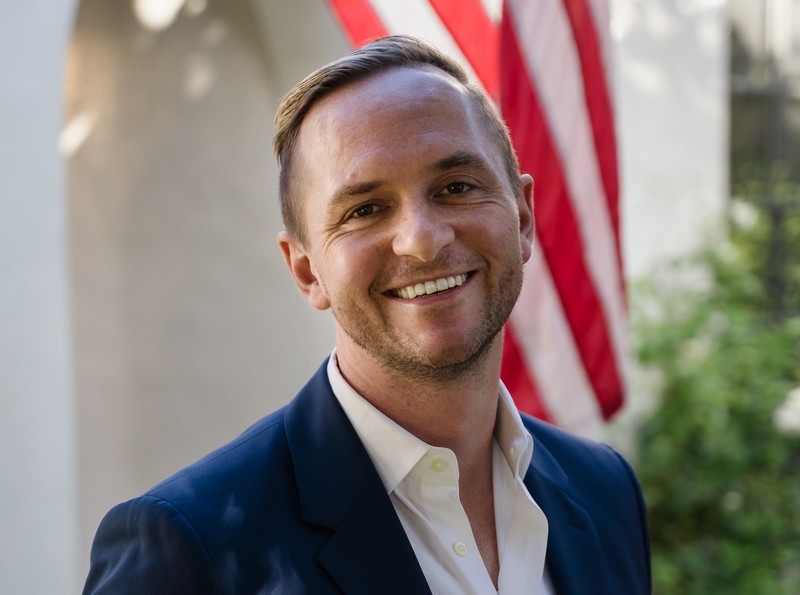Mayoral Candidate Craig Greiwe Uses ‘Ride Share Scooters’ and Supports the Use of Law Enforcement on L.A. Public Transit

Photo via Craig Greiwe’s campaign website.
Transportation is a central topic of life in Los Angeles, with urgent repercussions for the world at large. We seek city leaders who prioritize exceptional and affordable public transportation, street safety, and adequate active transportation infrastructure while centering issues related to affordable transit-oriented housing development and dealing with the city’s crisis of hit and runs. Before voting for our next L.A. mayor, we needed to know where the candidates stand on the essential issue of transportation equity. In a collaboration with CicLAvia, Los Angeles County Bicycle Coalition, Climate Resolve, Streets For All, Los Angeles Walks, Act-LA, POWER, IKAR, Asian Pacific Islander Forward Movement, Pacoima Beautiful, and MoveLA, L.A. TACO presents a candid questionnaire given to all of L.A.’s mayoral candidates, with their answers in English, Spanish, Chinese, and Korean. All questionnaires sent out to candidates were identical and all responses were provided by the candidates via email.
Getting Around in L.A.
How often do you walk, bike, ride transit, or otherwise get to your destinations without driving in L.A.? How would you judge the condition and importance of each of those transportation modes? How important is it for the next L.A. Mayor to experience all available transportation modes?
I am lucky that I can walk a lot in my neighborhood, and take “ride share” scooters to many locations nearby, and do. However, as many Angelenos know from first-hand experience, I am unable to utilize public transit options effectively as a full-time candidate for Mayor because of how difficult the system makes it to use them. Transit times are too long; routes are often incoherent and inaccessible to where I need to go; and I am beholden to a campaign schedule that does not allow me the luxury of time in transit. I have experienced and continue to use all options besides driving when available, but driving is still — for me and too many other Angelenos — an absolute necessity. In the meantime, the condition of each of these transportation models in Los Angeles is simply deplorable when compared to other cities. Far too few neighborhoods are walkable; far too many communities are shut out of the public transit network; our train/subway stops are too far apart; and transfer between systems (bus, subway, light rail, etc.) is too burdensome. We do not make it easy to use public transport in Los Angeles, or safe enough in enough places to use options besides driving, such as biking or walking. We are in this position because decades of empty promises and failed leadership from career politicians has put us here. Only a true outsider can take the reins to move us forward.
L.A. Metro Safety
As Mayor, how would you incorporate community-based support and safety strategies prioritizing the needs of vulnerable Angelenos?
As demonstrated by the recent attacks in New York, and the continuing rise in everyday crimes regardless of historic highs or lows, there is both a need for “big picture” security and day-to-day safety and security. This requires the use of multiple strategies and partners, including law enforcement and law enforcement alternatives. Communities must have a say in our strategy, but those communities must represent everyone, not a select few with the luxury of time and activism. The voice of the protestor has to be just as important as the voice of the single mother of two who doesn’t have time to participate in zoom meetings, canvassing, or activism. There must be an affirmative effort to engage everyone.
We must have safety on LA Metro, and I support the use of law enforcement as a valuable partner in ensuring that safety. However, the use of law enforcement does not absolve us from finding and building better alternatives over time. We should be fully funding a non-violent community engagement force focused on building trust and engagement with communities as detailed in the 2015 DOJ Community-Oriented Policing plan. We must work to make sure communities are a part of that planning and execution, and that the top priority of all our work is to keep the public safe, including those most vulnerable. Broad, unspecific knee jerk reactions (such as banning law enforcement from LA Metro) are unhelpful to concrete, specific, and thoughtful policy-making.
Vision Zero
How would you assess L.A. City’s Vision Zero policy, and what concrete steps would you take to implement its Vision Zero program by 2025? What role does the Mayor have in encouraging City Council members to take political risks in supporting Vision Zero projects and commitments like the City’s Mobility Plan 2035, that may remove parking or travel lanes?
I run my campaign based on honesty, even when it’s painful. As such, if we’re being honest, we must acknowledge that the Vision Zero and its associated projects are uniformly not just behind schedule or badly planned; they are largely just a disaster. We cannot accomplish Vision Zero without taking cars off the road, and we will never take enough cars off the road simply by using more public transit. Under my affordability plan (https://craigformayor.com/the-plans/#affordability), we will build enough housing so that people can afford to live near where they work, which is the secret to a livable city operating towards Vision Zero.
The mayor has a critical role in using the power of the public pulpit to drive City Council members to do the right thing, regardless of special interests and “political” implications, which he has historically not used. Because every Mayor and career politician for the last 20 years has been focused on “what comes next,” and catering to party interests, they have refused to make hard and bold choices. Similarly, as the only true outsider in this race with concrete plans in every area of policy, I’m also the only candidate for Mayor who is free from these forces – I am beholden not to a national party or decades of special interests and favors, but simply to the people who elect me to be their Mayor. I intend to bring the full force of that outsider status to Council members’ doorsteps to push for their action.
Better Busses
L.A. Metro’s current shortage of bus operators significantly impacts bus frequency and reliability. How would you address this problem and also further increase bus frequency and ensure service reliability as ridership rebounds? Do you support Metro’s advocacy of a fare-free transit system?
We have got to get the basics right in this city, which we don’t do. More buses, and more buses that operate on time, are essential. We need to create greater short-term incentives towards driver recruitment and look to long-term solutions, such as third-party partnerships and outsourcing, that provide advantages from private sector utilization. However, financial incentives , such as sign-on bonuses, must be temporary to avoid long-term unintended budgetary impacts, including on pensions.
Simply put, economic forces dictate that private enterprise “gets it right” more than government (because they have more financial accountability), and we either need to build that financial accountability into government, or utilize a blended model to drive results. I believe in moving towards a fare-free future transit system, but we must address the sustainability of that model before leaping to it. While we’re diverting billions of dollars every year into serving 60,000 homelessness without making progress, we are causing the remaining 3.9 million Angelenos to suffer in every resource area, including public transit. My plan — the only plan to end homelessness based on proven results across America — will allow us to put that money to use in areas like reducing and eliminating fares, improving our streets, and more. Every dollar spent on a lack of progress around homelessness is a dollar not spent making this city and its infrastructure better.
Budget and Community Representation
How would you create more participation, accountability, and transparency in the budgeting process for LADOT or LA Metro projects, especially among limited English proficient and low-income communities? How would you ensure that project funds are equitably distributed?
Right now, we put the burden of participation, accountability, and transparency on the people of this city, which is wrong. We ask people to show up to a hearing at 11 AM or 7 PM, we ask them to do their own research in arcane digital data systems that are barely usable, if they even contain current information. We ask them to sign up for email lists that they don’t even know about to be informed. That’s wrong.
As Mayor, I will put the burden of public participation and engagement on the government. We will establish minimum “touch” requirements of quotas for communities and affected populations, so that every project must engage with and get feedback from a minimum number of people in each community to move forward. We must create materials that “break down” every project into easy-to-read and digest elements that the public can understand in their language, on their terms, at their education level. And those materials must have minimum consumption requirements and advertising budgets, to ensure the members of the public are proactively briefed and engaged, rather than expected to “hunt” for information they may not even understand on their own. I will also advocate for an office of the public advocate whose job it is to be a thorn in the side of every elected official to make sure that this city is transparent and accountable to its people.
More Connected, Less Congested
What amenities and programs do you support to reduce traffic congestion, increase active transportation, and increase transit (bus and rail) ridership? As Mayor, how would you coordinate dozens of neighboring cities and public agencies to improve local and regional access to transportation modes aside from driving?
The number one way we can reduce traffic congestion is by building a city where people can live closer to where they work – a more affordable city, where our target is no more than 30% of any individual’s income spent on rent. My building and affordability plan — the only such written plan of any candidate — is how we get there. Increased density where it makes sense; increased by-right building; greater use of market forces and economic incentives; the conversion of all latent industrial zones into mixed use development, with fast-track approvals and bonuses for affordability components; and tying affordability covenants to market conditions rather than automatically expiring are just a few. We need to take action in Los Angeles for Los Angeles, without waiting for neighboring communities.
Then, separately, we must bring together neighboring communities with incentives that drive participation and engagement. Because Los Angeles is a dysfunctional mess, there is little reason to work with us. We must find a reason to bring neighboring agencies and cities to the table. Similarly, we must create compelling incentives for the public to increase ridership, and make sure those incentives are commonly understood. The city’s Metro Micro ride share program is a perfect example of failure – a smart program that can make it easier to get around, but one that the vast majority of Angelenos don’t even know about. We must not only find the right financial incentives to drive usage and participation; we must make sure everyone knows about them.
En Español
VIAJANDO POR LOS ÁNGELES
¿Con qué frecuencia camina, anda en bicicleta, viaja en transporte público o llega a donde necesita ir sin conducir en Los Ángeles? ¿Cuál considera que es la condición y la importancia de cada uno de esos medios de transporte? ¿Cuán importante es para el próximo alcalde/alcaldesa de Los Ángeles el conocer bien todos los medios de transporte disponibles?
Tengo la suerte de poder caminar mucho en mi vecindario y pasear en patinetas eléctricas de viaje compartido a muchos sitios cercanos. Sin embargo, como muchos angelinos lo saben por experiencia propia, no puedo utilizar las opciones de transporte público de manera efectiva como candidato a alcalde a tiempo completo pues el sistema dificulta utilizarlas. Toma mucho tiempo andar en el transporte público, las rutas están desorganizadas y son inaccesibles a donde necesito ir y tengo un horario de campaña que no me permite el lujo de andar en el transporte público. He utilizado y sigo usando todas las opciones aparte de conducir cuando están disponibles, pero conducir sigue siendo, para mí y para muchos angelinos, una necesidad absoluta. Mientras tanto, la condición de cada uno de estos modelos de transporte en Los Ángeles es simplemente deplorable en comparación con otras ciudades. Muy pocos vecindarios son transitables; muchas comunidades están excluidas de la red de transporte público; las paradas de nuestro sistema de tren subterráneo están demasiado separadas una de la otra; y el trasbordo entre sistemas (autobús, metro, tren ligero, etc.) se dificulta. No le hacemos fácil el uso del transporte público en Los Ángeles a la gente, ni lo hacemos lo suficientemente seguro en muchos lugares para utilizar alternativas en vez de conducir, como andar en bicicleta o caminar. Estamos en esta posición gracias a décadas de promesas sin cumplirse y el fallido liderazgo de politiqueros quienes nos han puesto aquí. Solo un verdadero candidato independiente (como yo) puede tomar las riendas para hacernos avanzar.
SEGURIDAD EN EL METRO DE LOS ÁNGELES
Como alcalde/alcaldesa, ¿cómo incorporaría estrategias de apoyo que se originan entre la comunidad y las de seguridad que priorizan las necesidades de los angelinos más vulnerables?
Como se demostró con los ataques recientes en Nueva York y el continuo aumento de los delitos del día a día, independientemente de los altibajos históricos, existe una necesidad de tener seguridad en general y seguridad a diario. Esto requiere el uso de múltiples estrategias y alianzas, incluyendo el uso de la fuerza policial y alternativas a su uso. Las comunidades deben tener una voz con respecto a nuestra estrategia, pero esas comunidades deben representar a todos, no a unos pocos elegidos con el lujo de tener tiempo para andar en activismo. La voz del manifestante debe ser tan importante como la voz de la madre soltera con dos hijos que no tiene tiempo para participar en reuniones virtuales, o para andar en campañas o en activismo. Debe haber un esfuerzo afirmativo para involucrar a todas las personas.
Debemos sentir seguridad en el transporte público y apoyo el uso de policías como un aliado valioso para garantizar la seguridad. Sin embargo, el uso de la fuerza policial no nos limita a encontrar y construir mejores alternativas con el tiempo. Debemos financiar una fuerza de participación comunitaria no violenta centrada en generar confianza y participación en las comunidades como se detalla en el Plan de Vigilancia Orientada a la Comunidad del Departamento de Justicia de 2015. Debemos trabajar para asegurar que las comunidades sean parte de esa planificación, la ejecución y que la principal prioridad de todo nuestro trabajo sea mantener la seguridad del público, incluidos los más vulnerables. Las reacciones irracionales (como prohibir que haya policía en el transporte) no ayudan a la formulación de normas concretas, específicas y reflexivas.
VISION ZERO
¿Cómo evaluaría la norma de Vision Zero de la ciudad de Los Ángeles y qué pasos concretos tomaría para implementar este programa para 2025? ¿Qué papel desempeña el alcalde/alcaldesa en exhortar a los miembros del Concilio para que tomen riesgos y apoyen la Vision Zero y se comprometan a realizar proyectos como el Plan de Movilidad de la Ciudad para 2035, el cual puede eliminar los carriles de estacionamiento o de viaje?
Dirijo mi campaña basándome en la honestidad, incluso cuando es dolorosa. Como tal, si somos honestos, debemos reconocer que Vision Zero y los proyectos relacionados con este programa no tienen uniformidad y no solo están retrasados o mal planificados y son en gran medida sólo un desastre. No podemos lograr una Vision Zero sin sacar a los carros de las carreteras y nunca sacaremos suficientes carros de las carreteras simplemente usando más transporte público. Bajo mi plan de asequibilidad (https://craigformayor.com/the-plans/#affordability), construiremos suficientes viviendas para que las personas puedan vivir cerca de donde trabajan, que es el secreto de una ciudad habitable que se orienta rumbo a una Vision Zero.
El alcalde juega un papel fundamental en el uso del poder desde el púlpito y exhorta a los miembros del Concilio para que hagan lo correcto, independientemente de los intereses especiales y las implicaciones “políticas” que no ha utilizado históricamente. Ya que en los últimos 20 años todos los alcaldes y politiqueros se han enfocado en “lo que viene después” y en satisfacer los intereses de los partidos, también se han negado a tomar decisiones difíciles y que requieren valentía. Así mismo, siendo el único candidato verdaderamente independiente en esta contienda electoral y con planes concretos en cada área de norma política, también soy el único candidato a alcalde que está libre de estas fuerzas - no estoy en deuda con un partido ni con décadas de intereses y favores especiales, sino simplemente a las personas que me eligen para ser su alcalde. Tengo la intención de llevar toda la fuerza de mi estatus como el candidato independiente en esto de la política hasta los miembros del Concilio para presionar a que tomen acción.
MEJOR SERVICIO DE AUTOBUSES
La actual escasez de operadores de autobuses de Metro afecta significativamente la frecuencia, la consistencia y el poder depender en los autobuses. ¿Cómo abordaría este problema al mismo tiempo que aumenta la frecuencia de los autobuses y garantiza la consistencia del servicio a medida que se recupera la cantidad de pasajeros? ¿Apoya la lucha por un sistema de transporte sin tarifas?
Tenemos que hacer lo básico bien hecho en esta ciudad, lo cual no hacemos. Es esencial tener más autobuses y más autobuses que operen a tiempo. Necesitamos crear mayores incentivos a corto plazo para la contratación de operadores y buscar soluciones a largo plazo, como colaboraciones con terceros y subcontratación que brinden ventajas de la utilización del sector privado. Sin embargo, los incentivos financieros, como los bonos de inscripción, deben ser temporales para evitar un impacto presupuestario no deseado a largo plazo, incluso en las pensiones.
En pocas palabras, las fuerzas económicas dictan que la empresa privada "hace las cosas bien" más que el gobierno (porque tienen más responsabilidad financiera) y necesitamos construir esa responsabilidad financiera en el gobierno o utilizar un modelo combinado para generar resultados. Creo en avanzar hacia un sistema de transporte sin tarifas en el futuro, pero debemos abordar la sostenibilidad de ese modelo antes de lanzarnos a ello. Ya que estamos desviando miles de millones de dólares cada año para atender a 60,000 personas sin hogar sin hacer gran progreso, estamos causando que los 3.9 millones de angelinos restantes sufran en todas las áreas por falta de recursos, incluyendo el transporte público. Mi plan, el único plan para terminar con la falta de vivienda que se fundamenta en resultados comprobados en todo Estados Unidos, nos permitirá usar ese dinero en áreas como reducir y eliminar tarifas, mejorar nuestras calles entre otras cosas más. Cada dólar gastado en la falta de progreso en torno a la falta de vivienda es un dólar que no se gasta en mejorar esta ciudad y su infraestructura.
EL PRESUPUESTO Y PARTICIPACIÓN DE LA COMUNIDAD
¿Cómo fomentaría más participación, responsabilidad y transparencia en el proceso de la creación de presupuestos para los proyectos del Departamento de Transporte de Los Ángeles (LADOT, por sus siglas en inglés) o Metro, especialmente entre las comunidades con dominio limitado del inglés y otras de bajos ingresos? ¿Cómo garantizaría que la distribución de fondos entre los proyectos se realice de manera equitativa?
En este momento le responsabilizamos por la participación, la rendición de cuentas y la transparencia a la población de esta ciudad, lo cual está mal hecho. Les pedimos a las personas que se presenten a una audiencia a las 11 am o 7 pm, les pedimos que hagan su propia investigación utilizando sistemas de datos digitales inaccesibles que apenas se pueden usar, si es que contienen información actualizada. Les pedimos que se inscriban en listas de correo electrónico que ni siquiera conocen para estar informados. Eso está muy mal.
Como alcalde, le daré la carga de la responsabilidad de la participación y el compromiso público al gobierno. Crearemos requisitos mínimos de “contacto” entre las comunidades y las poblaciones afectadas de modo que cada proyecto debe involucrar y obtener retroalimentación de un número mínimo de personas en cada comunidad para poder avanzar. Debemos crear materiales que expliquen paso a paso cada proyecto con elementos fáciles de leer y digerir para que el público pueda entender en su idioma, en sus términos y su nivel educativo. Y esos materiales deben tener requisitos mínimos de consumo y presupuestos publicitarios para garantizar que el público esté informado y comprometido de manera proactiva, en lugar de esperar que los "cacen" para obtener información que tal vez ni siquiera entiendan por sí mismos. También, abogaré por una oficina del defensor público cuya función se centre en ser una espina en el costado de cada funcionario electo para asegurar que esta ciudad sea transparente y responsable ante su gente.
MÁS CONEXIÓN, MENOS CONGESTIÓN
¿Qué servicios y programas apoya usted para reducir la congestión del tráfico, aumentar el transporte activo y aumentar el número de pasajeros (en autobús y tren)? Como alcalde/alcaldesa, ¿cómo coordinaría esfuerzos entre docenas de ciudades y organismos públicos para mejorar el acceso local y regional a los diversos medios de transporte aparte de conducir?
La principal manera en la que podemos reducir la congestión del tráfico es al crear una ciudad en donde las personas puedan vivir más cerca de donde trabajan, una ciudad más asequible, en donde nuestro objetivo sea no gastar más del 30% de los ingresos en el alquiler. Mi plan de construcción y asequibilidad, el único plan escrito de este tipo por cualquier candidato, es la fórmula para lograrlo. Tener mayor densidad en donde hace sentido; más edificios por derecho; utilizar más las oportunidades que ofrece el mercado además de incentivos económicos; la conversión de todas las zonas industriales en desarrollos de uso mixto, con procesos de aprobación acelerados y bonificaciones para quienes construyen vivienda asequible y vincular los convenios de asequibilidad a las condiciones del mercado en lugar de dejar que caduquen automáticamente, estos son solo algunos ejemplos. Necesitamos tomar acción en Los Ángeles para el bien de Los Ángeles sin esperar a que otras comunidades vecinas lo hagan.
Luego, por separado, debemos unificar a las comunidades adyacentes por medio de incentivos que impulsen su participación y compromiso. Dado que Los Ángeles es un desastre disfuncional, otras ciudades tienen pocas razones para trabajar con nosotros. Debemos encontrar una razón para traer a la mesa a las agencias y ciudades vecinas. Igualmente, debemos crear incentivos convincentes para que aumente el número de pasajeros y asegurarnos de que estos incentivos sean de beneficio común. El programa de viaje compartido Metro Micro es un ejemplo perfecto del fracaso: un programa inteligente que puede hacer que sea más fácil viajar, pero que la gran mayoría de los angelinos ni siquiera conoce. No solo debemos encontrar los incentivos financieros adecuados para impulsar el uso y la participación de la gente, también debemos garantizar que toda la gente conozca de su existencia.
In Mandarin
- 在洛杉矶的出行方式
在洛杉矶而不开车的情况下,您需要多久时间以步行、骑自行车、乘坐公交或以其他方式到达目的地?您如何判断每种交通方式的状况和重要性?对于下任洛杉矶市长来说,体验所有可用的交通方式有多重要?
我很幸运,我可以在我的社区里四处走走,并乘坐 "共享 "滑板车去附近的许多地方,而且确实如此。然而,正如许多洛杉矶人从第一手经验中了解到的那样,作为一个全职的市长候选人,我无法有效地利用公共交通,因为这个系统使我很难使用它们。公交时间太长;路线往往不连贯,无法到达我需要去的地方,而且我受制于竞选日程,不允许我有多余的时间乘坐公交。除了开车之外,我已经体验并继续使用所有选项,但对于我和太多其他洛杉矶人来说,开车仍然是绝对必要的。同时,与其他城市相比,洛杉矶的这些交通模式的状况简直令人惋惜。可步行的社区太少了;太多的社区被关在公共交通网络之外;我们的火车/地铁站相隔太远;系统之间的转换(公交车、地铁、轻轨等)也太麻烦了。在洛杉矶,我们没有让人们方便地使用公共交通,也没有让人们在足够的地方安全地使用除驾车之外的其他选择,如骑自行车或步行。我们之所以处于这样的境地,是因为几十年来职业政客的空洞承诺和失败的领导将我们置于此,所以只有真正的局外人才能推动我们前进。
- 洛杉矶地铁安全
作为一名市长,您将如何纳入以社区为基础的支持和安全策略,优先考虑弱势洛杉矶人的需求?
正如最近在纽约发生的袭击事件,以及无论在历史的高低点,日常犯罪持续上升所表明的那样,既需要顾全"大局"安全,也需要日常的安全保障。这需要使用多种策略和合作伙伴,包括执法和执法替代方案。社区必须对我们的策略有发言权,但这些社区必须代表每个人,而不是少数有时间和活动能力的人。抗议者的声音必须与那些没有时间参加Zoom会议、拉票或活动的两个孩子的单身母亲的声音一样重要。我们必须做出积极的努力,让每个人都参与进来。
我们必须保证洛杉矶地铁的安全,我支持使用执法部门作为确保安全的重要合作伙伴。然而,使用执法部门并不能免除我们寻找和建立更好的替代方案的时间。我们应该充分资助一支非暴力的社区参与力量,专注于与社区建立信任和参与,正如2015年司法部以社区为导向的警务计划中所详述的那样。我们必须努力确保社区是该计划和执行的一部分,而且我们所有工作的首要任务是保持公众安全,包括那些最脆弱的人。笼统的、不具体的下意识反应(如禁止在洛杉矶地铁执法)对具体的、具体的、深思熟虑的政策制定是无益的。
- 零死亡愿景
您如何评估洛杉矶市的“零死亡愿景”政策,以及您将采取哪些具体步骤到2025年实施其“零死亡愿景”计划?市长在鼓励市议会成员承担政治风险以支持“零死亡愿景”项目和承诺(如2035年城市交通计划)方面发挥什么作用,这些项目和承诺可能会取消停车位或行车道?
即使是非常艰苦,我的竞选活动是以诚实为基础的。因此,老实说,我们必须承认,"零死亡愿景"及其相关项目都不仅仅是落后于计划或计划不周,它们在很大程度上只是一场灾难。如果不把汽车从道路上赶走,我们就无法实现"零死亡愿景",而仅仅通过使用更多的公共交通,我们永远无法把足够的汽车从道路上赶走。根据我的可负担能力计划(https://craigformayor.com/the-plans/#affordability),我们将建造足够的住房,让人们能够负担得起工作地点附近的住所,这是一个宜居城市实现零死亡愿景的秘诀。
在不考虑特殊利益和"政治"的影响下,市长在利用公共讲坛的力量推动市议会成员做正确的事情方面具有关键作用,但在历史上没有市长使用过这种力量。因为在过去的20年里,每一位市长和职业政客都只专注于"下一步是什么",并迎合政党利益,他们拒绝做出艰难和大胆的选择。同样,作为这次竞选中唯一真正的局外人,我在每个政策领域都有具体的计划,我也是唯一不受这些力量影响的市长候选人——我不受国家政党或几十年的特殊利益和恩惠的影响,而只是受制于选我当市长的人民。我打算把这种局外人身份的全部力量带到议会成员的门口,推动他们采取行动。
- 更佳的公交车
洛杉矶地铁公司目前的公交车操作员短缺,严重影响了公交车班次和可靠性。您将如何解决这个问题,以及并随着乘客量的增加,进一步增加公交车的班次,确保服务的可靠性?您是否支持地铁公司倡导的免费交通系统?
我们必须把这个城市的基本问题解决好,但我们没有做到这一点。因为更多的公交车,以及更多准时运营的公交车,是至关重要的。我们需要为司机招聘创造更大的短期激励措施,并寻求长期的解决方案,如第三方合作和外包,这些方案可以从私营部门的利用中获得优势。然而,财务激励措施,如签约奖金,必须是暂时的,以避免长期的非预期预算影响,包括对养老金的影响。
简而言之,经济力量决定了私营企业比政府更“正确”(因为它们有更多的财务问责制),我们要么需要将这种财务问责制建立到政府中,要么利用混合模型来推动结果。我相信迈向无票价的未来交通系统,但我们必须在跳到这种模式之前解决该模式的可持续性问题。虽然我们每年将数十亿美元用于为60,000名游民提供服务而没有取得进展,但我们正在使剩余的390万洛杉矶人在每个资源领域遭受痛苦,包括公共交通。我的计划——基于美国各地经过验证的结果结束游民的唯一计划——将使我们能够将这笔钱用于降低和取消票价,改善街道等领域。花在游民问题上缺乏进展的每一美元,都是没有花在使这个城市及其基础设施变得更好的一美元。
- 预算和社区参与
您将如何在洛杉矶交通局或洛杉矶地铁项目的预算编制过程中,尤其是在英语水平有限和低收入社区中,创造更多的参与、问责和透明度?您将如何确保项目资金的公平分配?
现在,我们把参与、问责和透明度的重担放在了这座城市的人民身上,这是错误的。我们要求人们在上午 11 点或晚上 7 点出席听证会,我们要求他们在神秘的数字数据系统中进行自己的研究,就算是它们包含当前信息,这些系统也几乎是无法使用的。我们要求他们注册他们甚至不知道会被告知的电子邮件列表,这也是错误的。
作为一名市长,我将把公众参与和参与的负担放在政府身上。我们将为社区和受影响人群制定配额的最低“接触”要求,以便每个项目都必须与每个社区中最少数量的人接触并获得反馈后,才能向前迈进。我们必须创建材料,将每个项目“分解”成易于阅读和消化的内容,使公众可以按照他们的语言,根据他们的条件,在他们的教育水平上理解这些元素。这些材料必须具有最低消费要求和广告预算,以确保公众成员积极主动地了解情况并参与其中,而不是期望“寻找”他们自己甚至可能都不理解的信息。我还将倡导建立一个公共倡导者办公室,其工作是成为每个民选官员的眼中钉,以确保这座城市的透明度和对人民负责。
- 高连通,低拥堵
您支持哪些便利设施和计划来减少交通拥堵、增加交通流动量、和增加公交(公共汽车和铁路)乘客量?作为一名市长,除了开车之外,您将如何协调数十个邻近城市和公共机构,以改善当地和区域交通方式?
我们减少交通拥堵的首要方法是建立一个人们可以住在离他们工作地点更近的城市——一个更实惠的城市,我们的目标是任何个人的租金不超过其收入的30%。我的建筑和可负担能力计划——所有候选人中唯一这样的书面计划——就是我们如何实现这一目标。在有意义的地方增加密度;增加合法建筑;更多地利用市场力量和经济激励措施;将所有潜在的工业区转化为混合用途的发展,并对可负担能力部分进行快速审批和奖励;以及将可负担能力契约与市场条件挂钩,而不是让它们自动到期,这些只是其中的几个例子。我们不能等待邻近社区,我们需要自己在洛杉矶为洛杉矶采取行动。
然后,我们必须分别用激励措施将邻近的社区聚集在一起,以推动其参与和投入。因为洛杉矶是一个功能紊乱的烂摊子,极少理由能让别人与我们合作。我们必须找到一个让周边机构和城市参与进来的理由。同样,我们必须为公众创造令人信服的激励措施,以增加乘客量,并确保这些激励措施得到普遍理解。这座城市的地铁微乘共享项目就是一个完美的失败例子——一个智能的项目,美其名说是可以让出行变得更容易,但绝大多数安琪儿人甚至都不知道。我们不仅要找到正确的财政激励措施来推动使用和参与,我们必须确保每个人都知道这些措施。
In Korean
저는 주변 지역을 많이 걸을 수 있고 인근의 여러 곳에 '공유' 스쿠터를 탈 수 있기에 운이 좋은 편이라고 생각합니다. 하지만 대부분의 로스앤젤레스 시민들도 직접 경험해보셔서 아시듯이, 저는 전임 시장 후보로서 대중교통 옵션은 효과적으로 활용하지 못하고 있습니다. 대중교통 체계를 이용하기 힘들기 때문이죠. 주행 시간은 너무 길고 노선은 종종 일관성이 없고 원하는 목적지까지 운행하지 않기도 합니다. 게다가 캠페인 일정상 대중교통으로 시간을 보내는 호사를 부릴 수 없기도 하고요. 가능한 경우 운전 이외의 모든 선택안을 경험했고 계속 이용하고는 있습니다만, 저뿐만 아니라 로스앤젤레스 시민 대부분에게 운전은 절대적으로 필요한 것입니다. 게다가 로스엔젤레스의 각 교통 체계 상태는 다른 도시와 비교할 때 개탄스러울 뿐입니다. 도보로 갈 수 있는 지역이 너무 적고, 너무 많은 지역사회가 대중교통망에서 제외되었습니다. 기차/지하철 정류장은 너무 멀리 떨어져 있고, 시스템(버스, 지하철, 경전철 등) 간의 이동은 버거울 정도입니다. 로스엔젤레스에서 대중교통 이용은 쉽지 않고, 자전거나 도보 등 운전 이외의 선택안을 이용할 수 있을 만큼 충분히 안전하지도 않습니다. 수십 년에 걸친 공허한 공약들과 직업 정치인의 실패한 리더십으로 인해 이러한 상태에 이르게 된 것입니다. 진정한 외부 인사만이 우리를 이끌고 나아가게 할 수 있습니다.
최근 뉴욕시에서 발생한 공격 행위와 역사적으로 최고 수준이든 최저 수준이든 지속적으로 증가하는 일상적인 범죄에서 알 수 있듯이 '거시적인' 보안 및 일상적 수준에서의 안전과 보안이 모두 필요합니다. 이를 위해서는 법집행 및 법집행 대안을 비롯해 다양한 전략과 협력 관계를 이용해야 합니다. 지역사회는 이 같은 전략에 발언권이 있어야 하고, 이러한 지역사회는 시간과 활동주의로 여유를 부릴 수 있는 선택된 소수가 아닌 모든 주민을 대표해야 합니다. Zoom 회의, 유세 현장, 적극적 활동에 참여할 시간이 없는 두 아이를 키우는 싱글맘의 목소리만큼 이의 제기자의 목소리는 중요하게 다루어져야 합니다. 모든 사람을 참여시키려는 적극적인 노력이 있어야 합니다.
우리는 LA Metro의 안전을 확보해야 하며, 저는 이러한 안전을 보장하는 소중한 협력자로서 법집행기관의 활동을 지지합니다. 그러나 법집행기관을 이용한다고 해서 시간이 지남에 따라 더 나은 대안을 찾고 이를 구축해야 하는 책임에서 벗어나는 것은 아닙니다. 우리는 2015 사법부 지역사회 지향적 경찰활동(DOJ Community-Oriented Policing) 계획에 자세히 설명된 대로 지역사회와의 신뢰 구축 및 참여에 중점을 둔 비폭력 지역사회 참여 집단에 충분한 자금을 지원해야 합니다. 우리는 지역사회가 그러한 계획의 수립과 실행의 일부가 되도록 노력해야 하며, 가장 취약한 계층을 포함해 대중을 안전하게 지키는 것이 모든 활동의 최우선 순위가 되어야 합니다. 광범위하고 구체적이지 못한 기계적 대응(LA Metro에서 법집행 금지 등)은 사실에 의거한 구체적이고 사려 깊은 정책 결정에 도움이 되지 않습니다.
저는 고통스럽더라도 정직함을 바탕으로 캠페인을 진행합니다. 그런 면에서 솔직히 Vision Zero 및 관련 프로젝트가 한결같이 일정보다 뒤처진 상태이거나 잘못 계획되었을 뿐만 아니라 대체로 재난 수준이라는 점을 인정해야 합니다. 거리에서 자동차를 줄이지 않고는 Vision Zero를 달성할 수 없으며, 단순히 대중교통을 더 많이 이용한다고 해서 거리에서 충분한 수의 자동차를 줄일 수 있는 것도 아닙니다. 저의 적정 주거 계획(https://craigformayor.com/the-plans/#affordability)에 따라 시민들이 직장 근처에서 살 수 있도록 충분한 주택을 지을 것이며, 이는 Vision Zero를 향해 나아가는 살기 좋은 도시를 만들기 위한 비결입니다.
시장은 특정의 이해관계와 역사적으로 사용한 적이 없는 '정치적' 영향에 관계없이 시의회 의원들이 옳은 일을 하도록 공직자의 권한을 이용하는 데 중요한 역할을 합니다. 지난 20년 동안 모든 시장과 직업 정치인은 '앞으로 닥칠 일'과 정당의 이익에만 초점을 맞추었기 때문에 힘들고 과감한 결정이 필요한 선택을 거부해 왔습니다. 마찬가지로, 이 선거의 모든 정책 영역에서 구체적인 계획을 가진 유일하고 진정한 외부인으로서 저는 이러한 세력에서 자유로운 유일한 시장 후보이기도 합니다. 저는 한 국가 정당이나 수십 년간 이어온 특별한 이해관계와 조력관계가 아닌 단순히 저를 시장으로 뽑아주신 분들만을 위하고 의지합니다. 저는 외부인으로서 모든 힘을 시의원들의 목전까지 동원해 그들의 행동을 촉구할 생각입니다.
우리는 우리가 하지 않고 있는 이 도시의 기본을 바로잡아야 합니다. 버스 충원과 정시에 운행하는 버스 증설이 필수입니다. 기사 채용에 대한 보다 효과적인 단기 장려책를 마련하고 민간부문 활용의 이점을 제공하는 제3자 파트너십 및 아웃소싱과 같은 장기적 해결책을 모색해야 합니다. 그러나 등록 보너스와 같은 금전적 장려책은 연금을 포함하여 장기적으로 의도하지 않은 예산상의 영향을 피하기 위한 임시방편으로 활용해야 합니다.
간단히 말해서, 민간 기업들이 정부보다 더 '올바르게 행동'하도록 만들 수 있는 것은 경제적 힘이며(민간 기업이 더 많은 재정적 책임을 지니고 있기 때문에) 우리는 정부에 재정적 책임을 구축하거나 결과를 이끌어내기 위해 절충안을 활용해야 합니다. 저는 향후 무상 운임 교통 시스템을 추진해야 한다고 생각합니다만, 이러한 모델로 도약하기 전에 그 모델의 지속가능성을 해결해야 합니다. 60,000명의 노숙인을 위해 매년 수십억 달러를 아무런 진전도 없이 사용하는 동안, 나머지 390만 명의 로스앤젤레스 시민들은 대중교통을 비롯한 모든 자원 영역에서 부담을 겪고 있습니다. 미국 전역에서 입증된 결과를 바탕으로 노숙인을 종식시키려는 유일한 계획인 제 계획을 통해 노숙인에게 쓰이는 자금을 요금 인하 및 폐지, 거리 개선 등과 같은 분야에 사용할 수 있습니다. 노숙인 문제를 둘러싸고 진전 없이 지출되는 모든 비용은 이 도시와 기반 시설을 개선하는 데 쓰이지 못한 자금입니다.
바로 지금, 우리는 시민들에게 참여, 책임의식 및 투명성에 대한 부담을 지우고 있지만 이는 잘못된 것입니다. 우리는 시민들에게 오전 11시나 오후 7시에 청문에 참석하도록 요청하고, 최신 정보가 수록되어 있어도 거의 사용할 수 없는 난해한 디지털 데이터 시스템에 접속하여 직접 살펴보도록 요청하고 있습니다. 우리는 이메일 목록에 등록해 주십사 요청하지만 이분들은 정작 고지를 받은 사실도 알지 못합니다. 이는 잘못된 것이 분명합니다.
저는 시장으로서 시민 참여와 관여의 부담을 정부에 맡길 것입니다. 지역사회 및 영향을 받는 계층에 대한 최소 '접촉' 요건 할당을 설정하여 모든 프로젝트를 진행시키기 위해 각 지역사회별로 최소 인원과 협력하고 피드백을 받게 할 것입니다. 모든 프로젝트를 일반 시민이 각자의 언어와 용어, 교육 수준에서 이해할 수 있게 읽기 쉽고 판별 가능한 요소로 '세분화'한 자료를 만들어야 합니다. 그리고 대중이 이해하지 못할 수도 있는 정보를 스스로 '조사'할 것으로 기대하기보다 이러한 자료에 대해 사전에 간략히 설명하고 참여할 수 있도록 하는 최소한의 소비 요건과 광고 예산을 마련해야 합니다. 또한 우리 도시가 투명하고 모두에게 책임 있는 도시가 되도록 모든 선출 공무원 편에서 가시 역할을 하는 공익 옹호자의 직무를 옹호할 것입니다.
교통 혼잡을 줄일 수 있는 가장 좋은 한 가지 방법은 시민들이 일하는 곳에서 더 가깝게 살 수 있는 도시, 즉 임대료 지출이 개인소득의 30%를 넘지 않는 것을 목표로 하는 적정한 도시 건설하는 것입니다. 후보자의 계획 중 유일한 서면 계획인, 저의 건설 및 적정 주거 계획은 목표 달성을 위한 방안입니다. 타당성이 있는 지역의 인구 밀도 증대, 올바르게 허가된 건물 증대, 자유 시장 방식과 경제적 장려책의 효과적인 사용, 모든 잠재적 산업 구역의 복합 용도 개발지 전환, 적정 비용의 요소를 위한 신속한 승인 및 보너스 처리, 자동 만료가 아닌 시장 상황에 따른 적정 약정 체결 등은 그 중 일부에 불과합니다. 이웃 지역사회의 변화를 기다리지만 말고 로스앤젤레스를 위해 로스앤젤레스에서 조치를 취해야 합니다.
그런 다음 별도로 참여와 관여를 유도하는 장려책으로 이웃 지역사회를 한데 모아야 합니다. 로스엔젤레스가 제대로 기능하지 않기 때문에 이웃 지역사회는 우리와 협력할 이유가 거의 없습니다. 우리는 이웃 기관들과 도시들이 우리와 함께 협력해야 하는 이유를 찾아야 합니다. 마찬가지로 승객 수를 늘리기 위한 대중을 상대로 장려책을 마련하고, 이러한 장려책을 쉽게 이해할 수 있게 해야 합니다. 도시의 Metro Micro 승차 공유 프로그램은 완벽한 실패 사례입니다. 더 쉽게 이동할 수 있게 하는 스마트 프로그램이지만, 대다수의 로스앤젤레스 시민들은 이에 대해 전혀 알지 못합니다. 우리는 사용과 참여를 유도하기 위해 올바른 금전적 장려책을 모색해야 할 뿐만 아니라 모든 시민이 이에 대해 알게 해야 할 것입니다.
Stay in touch
Sign up for our free newsletter
More from L.A. TACO
How Your Business Can Benefit From Sponsoring L.A. TACO
When your company sponsors L.A. TACO, you receive a variety of quick and cost-effective benefits for far less than what we price our traditional advertisements and social media mentions at.
Juárez-Style Burritos Have Arrived in Southern California, And They are Already Selling Out In Less than An Hour
The month-old strip mall taquería in Anaheim make all their flour tortillas from scratch using both lard and butter, resulting in an extremely tender vehicle for their juicy guisados like carne en su jugo, carne deshebrada, chile colorado, chile relleno, and chicharrón. Every tortilla is cooked to order, too.
Urgent: L.A. TACO Falling Short of Fundraising Goals and Needs Your Support
Emergency. This is not a test. This is not a ruse. This is not a marketing scheme. We need your support if we're going to make it and every single membership counts.
What To Eat In L.A. This Weekend: Mexican-Style Pastrami, ‘Trashburgers,’ and Flamin’ Jim Morrisons
Plus, a new shawarma spot in Tarzana and the country's first wine festival dedicated solely to orange "skin contact" wine happening in Hollywood.




